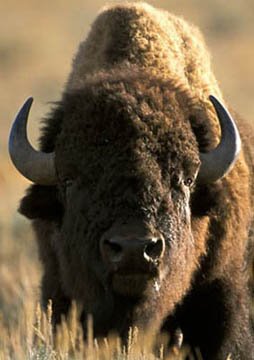 Ethan, water bottle and walking stick at the ready, at an observation tower above Fu Dog Garden at Allerton Park. He is already soaking wet and we had not yet started our trail trek.
Ethan, water bottle and walking stick at the ready, at an observation tower above Fu Dog Garden at Allerton Park. He is already soaking wet and we had not yet started our trail trek.Tuesday, May 26, 2009
Trooper
 Ethan, water bottle and walking stick at the ready, at an observation tower above Fu Dog Garden at Allerton Park. He is already soaking wet and we had not yet started our trail trek.
Ethan, water bottle and walking stick at the ready, at an observation tower above Fu Dog Garden at Allerton Park. He is already soaking wet and we had not yet started our trail trek.Friday, May 22, 2009
Warrior: Rest in Peace, Buddy Lamont
 Buddy Lamont is the second person from the right in this photo taken during the siege of the village of Wounded Knee on the Pine Ridge Indian Reservation in 1973.
Buddy Lamont is the second person from the right in this photo taken during the siege of the village of Wounded Knee on the Pine Ridge Indian Reservation in 1973.  Top photo: Taken a few days after the 1890 massacre at Wounded Knee, this is the scene of the mass burial trench of the Indian victims. Bottom photo: The burial scene today. Buddy's grave (inset photo) is just to the left of the 1890 memorial marker in the middle center of photo.
Top photo: Taken a few days after the 1890 massacre at Wounded Knee, this is the scene of the mass burial trench of the Indian victims. Bottom photo: The burial scene today. Buddy's grave (inset photo) is just to the left of the 1890 memorial marker in the middle center of photo. One of the Indian bunkers during the siege of Wounded Knee in 1973. In the left background can be seen the memorial marker for the 1890 Wounded Knee massacre. The church in the background was burned to the ground by unknown persons shortly after the siege ended. Some say it was destroyed to spare tourists the sight of bullet holes in the building's siding.
One of the Indian bunkers during the siege of Wounded Knee in 1973. In the left background can be seen the memorial marker for the 1890 Wounded Knee massacre. The church in the background was burned to the ground by unknown persons shortly after the siege ended. Some say it was destroyed to spare tourists the sight of bullet holes in the building's siding.While reading about South Dakota's Pine Ridge Reservation and its historic village of Wounded Knee, where about 300 Indians (many of them women, children, and elderly) were massacred by US. cavalrymen in December 1890, I came across a reference to the fate of a modern-day warrior.
Buddy Lamont, a 31-year-old Oglala Lakota (Sioux tribe) Indian and a Vietnam veteran, joined other Native Americans in the takeover of the village of Wounded Knee in South Dakota in 1973. The corruption of the local tribal government combined with the extreme poverty on the reservation had boiled over into a confrontation that turned ugly and forced the FBI and U.S. marshals to lay siege to the town as the Indians dug in to hold their position. Buddy was not a member of the American Indian Movement (AIM), but when his people called in AIM members for help, Buddy was ready for whatever came. Many, including Buddy, were armed because the local leader and his GOONs (Guardians of the Oglala Nation) at times used extreme violence.
Buddy, an easygoing, popular, well-repected member of his tribe, was shot through the heart by an FBI sharpshooter from long range when he vacated a bunker that had been tear gassed. The firefight was so intense that medics could not get to Buddy for two hours; he probably died almost instantly.
Wednesday, May 20, 2009
Poverty at Pine Ridge
 Agnes Ghost plays with a bow in her yard near Wounded Knee at the Pine Ridge Indian Reservation in South Dakota.
Agnes Ghost plays with a bow in her yard near Wounded Knee at the Pine Ridge Indian Reservation in South Dakota.  A member of the Blood gang at the 1890 Wounded Knee massacre mass grave site on the hill above town. Wounded Knee is the site of frequent gang violence.
A member of the Blood gang at the 1890 Wounded Knee massacre mass grave site on the hill above town. Wounded Knee is the site of frequent gang violence. Pine Ridge Reservation visitors are greeted by some of the tribe's buffalo. There was great joy at the Reservation in 2004 when yearling buffalo were released to live on Indian land.
Pine Ridge Reservation visitors are greeted by some of the tribe's buffalo. There was great joy at the Reservation in 2004 when yearling buffalo were released to live on Indian land.To get an idea of the conditions on the reservation by one who was there, take time to read THIS.
By far the best collection of photos I've seen of the life of many residents on the Pine Ridge Reservation is HERE (click Photo Galleries I, then click Pine Ridge and click on individual photos at bottom). Haunting images.
PINE RIDGE RESERVATION STATISTICS
Unemployment rate of 80-90%
Per capita income of $4,000
8 Times the United States rate of diabetes
5 Times the United States rate of cervical cancer
Twice the rate of heart disease
8 Times the United States rate of Tuberculosis
Alcoholism rate estimated as high as 80%
1 in 4 infants born with fetal alcohol syndrome or effects
Suicide rate more than twice the national rate
Teen suicide rate 4 times the national rate
Infant mortality is three times the national rate
Life expectancy on Pine Ridge is the lowest in the United States and the 2nd lowest in the Western Hemisphere. Only Haiti has a lower rate.
Friday, May 15, 2009
Wounded Knee
 A poverty-stricken Oglala Lakota (Sioux) child in the Wounded Knee District of the Pine Ridge Indian Reservation.
A poverty-stricken Oglala Lakota (Sioux) child in the Wounded Knee District of the Pine Ridge Indian Reservation.After viewing "Wounded Knee," the final installment of the PBS series "We Shall Remain," I have become immersed in Wounded Knee and the history of its people. In short, horrible living conditions for most of the district's residents, part of the vast Pine Ridge Reservation in South Dakota. The Obama Adminstration's proposed 2010 budget calls for the following gravely needed funds for Native Americans of our nation:
$4 billion for Indian Health Services, a 13 percent increase over 2009 and the largest increase in 20 years. The money would be used to contract with health providers on reservation land, raise money for urban health centers that primarily treat Native Americans, and help build health facilities in Alaska, Arizona and South Dakota.
$304 million for public safety funding - a 12 percent increase - through the Bureau of Indian Affairs. The money would expand police presence on reservations, refurbish crumbling tribal jails and improve court services.
Almost $800 million for Bureau of Indian Affairs education programs - an 11 percent increase. Some of the money would pay for public schools, tribal colleges and scholarships for Native American students.
I'll soon show through photos and text just how bad conditions are at Wounded Knee. It will be a feeble attempt, but I hope to give you some idea of the plight of the people there.
Friday, May 08, 2009
Wednesday, May 06, 2009
Mauling by a Bear is in Order
This is pathetic; the worst kind of hunting. "Wild" buffalo, indeed. The "hunt" took place HERE. Yeah, we really have a lot of roaming, wild big game in the Illinois cornfields. Manufactured hunting at its best. Viking devoured by a Chicago Bear? Justice.
Friday, May 01, 2009
Gotta Get Me One of These
 Wolf Woman likes llamas. While hiking in the Tennessee mountains she saw llamas used as pack animals. I think she would like to have a small herd of them, so for fun I thought I'd do some research on the critters. THIS site has some basics, while THIS fact-filled site claims "Llamas learn by behavior, all the time. It is part of their survival tactics. They will watch your small body movements, and even the expression on your face." Hmm.
Wolf Woman likes llamas. While hiking in the Tennessee mountains she saw llamas used as pack animals. I think she would like to have a small herd of them, so for fun I thought I'd do some research on the critters. THIS site has some basics, while THIS fact-filled site claims "Llamas learn by behavior, all the time. It is part of their survival tactics. They will watch your small body movements, and even the expression on your face." Hmm. They come in a variety of colors, and apparently make good guardians, as a New York Times article notes: "The rationale for llamas is somewhat different than for other types of livestock. Sheep ranchers acquire llamas as guard animals for their flocks. The sheep's natural predators, foxes and coyotes, generally will not tangle with a llama, which can be more than six feet tall. Llamas get along quite nicely with sheep, and when a llama senses danger, it emits a high-pitched whinny that alerts the farmer to bring the shotgun."
They come in a variety of colors, and apparently make good guardians, as a New York Times article notes: "The rationale for llamas is somewhat different than for other types of livestock. Sheep ranchers acquire llamas as guard animals for their flocks. The sheep's natural predators, foxes and coyotes, generally will not tangle with a llama, which can be more than six feet tall. Llamas get along quite nicely with sheep, and when a llama senses danger, it emits a high-pitched whinny that alerts the farmer to bring the shotgun." And they seem to be reliable, hard workers, like this train of llamas on the job in the Tennessee mountains. Leading the llamas in this photo is a reporter, who was given temporary charge of the pack: "The llamas didn't make a sound when they walked," the reporter noted. "Despite that my shoes were crunching twigs and kicking rocks, there was no sound coming from the llamas. It was a little freaky. Actually, it was really freaky. If I didn't turn around and look, it felt as if I was holding a rope that was connected to nothing. I might as well have been leading a team of ghosts."
And they seem to be reliable, hard workers, like this train of llamas on the job in the Tennessee mountains. Leading the llamas in this photo is a reporter, who was given temporary charge of the pack: "The llamas didn't make a sound when they walked," the reporter noted. "Despite that my shoes were crunching twigs and kicking rocks, there was no sound coming from the llamas. It was a little freaky. Actually, it was really freaky. If I didn't turn around and look, it felt as if I was holding a rope that was connected to nothing. I might as well have been leading a team of ghosts."  Backpacking llamas. I could have used one of these during my Appalachian Trail hikes. Very useful animals, as THIS article points out. I've thought of becoming a buffalo shepherd in my retirement, but a llama handler could be an option.
Backpacking llamas. I could have used one of these during my Appalachian Trail hikes. Very useful animals, as THIS article points out. I've thought of becoming a buffalo shepherd in my retirement, but a llama handler could be an option.








